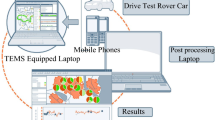Abstract
We study on the implementation flow of the radio computerized tomography (RCT) prediction method. A case in real cellular mobile radio (CMR) system together with the prediction results are also presented. As shown by the results, the RCT prediction method is marked for its convenience and rapidity, as well as its relative high precision even when the prediction procedure is highly simplified. Since it is developed according to the characteristics of wireless communication environments of our country and has concurrently merits from both statistical and deterministic prediction models, the RCT prediction method is in good agreement with engineering practices in cellular mobile communication in cities at home. Optimized by combining with other techniques, further improvement could be achieved in the stability and precision of the RCT prediction method which now serves as the core part of a software tool for commercial use in CMR system analysis and optimization.
Similar content being viewed by others
References
Okumura Y, Ohmori E, Kawano T,et al. Field Strength and Its Variability in VHF and UHF Land-mobile Radio Service.Rev Elect Commun Lab, 1968,16: 825–873.
Hata M. Empirical Formula for Propagation Loss in Land Mobile Radio Service.IEEE Trans Veh Technol, 1980.VT-29: 317–325.
Kurner T, Cichon D J, Wiesbeck W. Concepts and Results for 3-D Digital Terrain-based Wave Propagation Models: An Overview.IEEE J Select Areas Commun, 1993,11: 1002–1012.
Liang G, Bertoni H L. A New Approach to 3-D Ray Tracing for Propagation Prediction in Cities.IEEE Trans Antennas Propaga, 1998,46: 853–863.
Kim S C, Guarino B J, Willis III T M,et al. Radio Propagation Measurements and Prediction Using Three-Dimensional Ray Tracing in Urban Environments at 908 MHz and 1.9 GHz.IEEE Trans Veh Technol, 1999,48(3): 931–946.
Censor Y. Finite Series-Expansion Reconstruction Methods.Proc IEEE, 1983,71: 409–419.
Xu Ji-sheng, Ma Shu-ying, Yang Qi-han,et al. Tomographic Diagnosis of the Ionospheric Equatorial Anomaly in the East-Asia Region: Experiment and Early Results.Chinese J of Geophysics, 1995,57(4): 467–478.
Author information
Authors and Affiliations
Additional information
Biography: Yu Sheng-bing (1974-), male, Ph. D candidate, research interest: theory analysis and application development of radio propagation in wireless communication systems.
Rights and permissions
About this article
Cite this article
Sheng-bing, Y., Ji-sheng, X. The RCT approach for cell coverage prediction (II): Experiment and early results. Wuhan Univ. J. Nat. Sci. 6, 796–800 (2001). https://doi.org/10.1007/BF02850904
Received:
Issue Date:
DOI: https://doi.org/10.1007/BF02850904
Key words
- cellular mobile radio (CMR)
- radio computerized tomography (RCT)
- reconstruction
- cell coverage prediction
- propagation loss
- scan test




